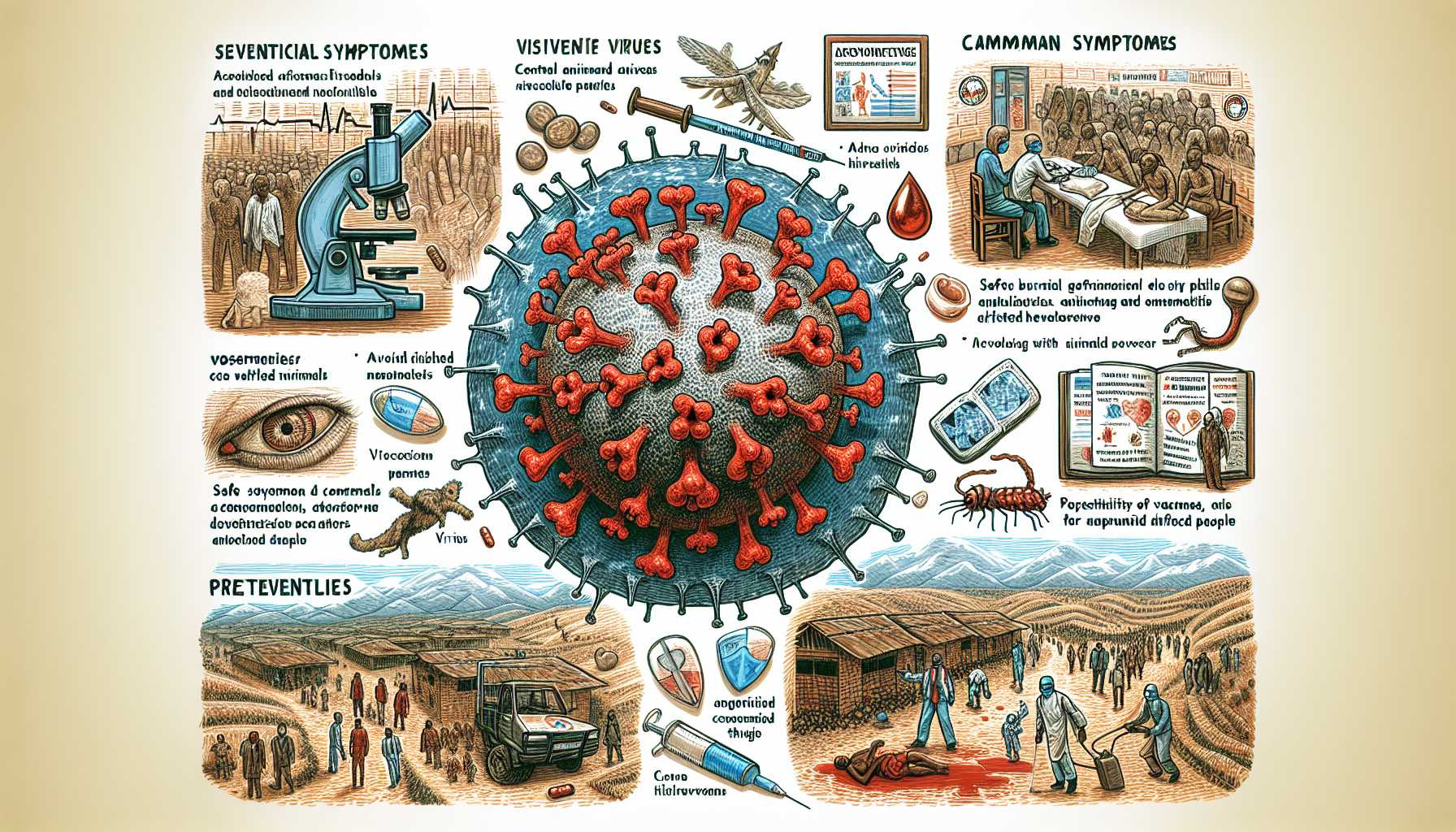
Understanding Ebola Virus Disease Symptoms and Prevention
Ebola virus disease is a severe and often fatal illness caused by the Ebola virus, which is transmitted to humans from wild animals and spreads through direct contact with infected bodily fluids.
ebolra baireoseu jilbyeong-eun ebolra baireoseu-ro inhae bal saenghaneun simgagha-go jongjong chimyeongjeogin jilbyeong-euro, yasang dongmul-eseo ingan-eulo jeonpahago gamyeonhan cheyaeg-gwa-ui jijeob jeopchog-eul tonghae peojipnida.
에볼라 바이러스 질병은 에볼라 바이러스로 인해 발생하는 심각하고 종종 치명적인 질병으로, 야생 동물에서 인간으로 전파되며 감염된 체액과의 직접 접촉을 통해 퍼집니다.
Symptoms typically appear 2 to 21 days after exposure and may include fever, severe headache, muscle pain, weakness, fatigue, diarrhea, vomiting, abdominal pain, and unexplained hemorrhaging.
jeungsang-eun botong nochul hu 2il-eseo 21il sai-e natana-myeo, balyeol, simhan dupong, geun-euk-tong, mulyeog-gam, piro, seolsa, guto, bok-tong mit seolmyengdoeji an-eun chulhyeol-i poham-doel su itseumnida.
증상은 보통 노출 후 2일에서 21일 사이에 나타나며, 발열, 심한 두통, 근육통, 무력감, 피로, 설사, 구토, 복통 및 설명되지 않은 출혈이 포함될 수 있습니다.
The disease has a high mortality rate, and outbreaks can occur in sporadic episodes in certain regions, notably in Central and West Africa.
i jilbyeong-eun nop-eun samangryul-eul gadigo iss-eumyeo, jijeongdoen jiyeog, teugbyeolhi jungang mit seobu apeulika-eseo sanbaljeog-in episeudoe-eseo bal saenghal su issseumnida.
이 질병은 높은 사망률을 가지고 있으며, 지정된 지역, 특히 중앙 및 서부 아프리카에서 산발적인 에피소드에서 발생할 수 있습니다.
Diagnosis is challenging due to the similarity of symptoms to other diseases, requiring laboratory tests to confirm the presence of the virus.
jindan-eun jeungsang-i daleun jilbyeong-gwa yusahagi ttaemun-e eoryeou-myeo, baireoseu-ui jonjae-reul hwaginhagi wihae silheom-sil geomsa-ga pil-yo-hamnida.
진단은 증상이 다른 질병과 유사하기 때문에 어려우며, 바이러스의 존재를 확인하기 위해 실험실 검사가 필요합니다.
Early supportive care—including rehydration and symptomatic treatment—can improve survival rates.
jogi jiji chilyo—jaesubun-gwa jeungsang chiryoreul pohamhayeo—saengjon-yul-eul hyangsang-sikil su itseumnida.
조기 지지 치료—재수분과 증상 치료를 포함하여—생존율을 향상시킬 수 있습니다.
Preventive measures include avoiding contact with infected individuals, safe burial practices, and minimizing exposure to potentially infected wildlife.
yebang jochineun gamyeon-doen gaein-gwa-ui jeopchog-eul pihago, anjeonhan jangnye gwanhaeng-eul pohamhameo, gamyeon wihyeom-i issneun yasang dongmul-e daehan nochul-eul choesohwanun geos-imnida.
예방 조치는 감염된 개인과의 접촉을 피하고, 안전한 장례 관행을 포함하며, 감염 위험이 있는 야생 동물에 대한 노출을 최소화하는 것입니다.
Effective vaccines and treatments are being developed to enhance future responses to outbreaks.
hyogwa-jeog-in baeksin-gwa chilyoje-ga gaebal-doego iss-eo hyanghu bal saeng-e daehan daeung-eul ganghwa-hago iss-seumnida.
효과적인 백신과 치료제가 개발되고 있어 향후 발생에 대한 대응을 강화하고 있습니다.
Public health strategies focus on controlling outbreaks and preparing for potential future incidents, emphasizing the importance of surveillance, community engagement, and rapid response to new cases.
gonggong geongang jeollyak-eun bal saeng-eul tongjehago jamjaejeog-in mirae sageon-e daebi-haneun de chojeom-eul majchumyeo, gamsi, jiyeog sahoe chamyeo mit sin-gyu sal-e daehan sinsokhan daeung-ui jungyoseong-eul gangjo-hamnida.
공공 건강 전략은 발생을 통제하고 잠재적인 미래 사건에 대비하는 데 초점을 맞추며, 감시, 지역 사회 참여 및 신규 사례에 대한 신속한 대응의 중요성을 강조합니다.
Awareness and understanding of Ebola virus disease are crucial for prevention and management, particularly in regions where the virus is endemic.
ebolra baireoseu jilbyeong-e daehan insig-gwa ihae-neun yeobang mit gwalli-e jungyo-hamyeo, teugbyeolhi baireoseu-ga pungto byeongin jiyeog-eseo deoul jungyohamnida.
에볼라 바이러스 질병에 대한 인식과 이해는 예방 및 관리에 중요하며, 특히 바이러스가 풍토병인 지역에서 더욱 중요합니다.
Based on this article
